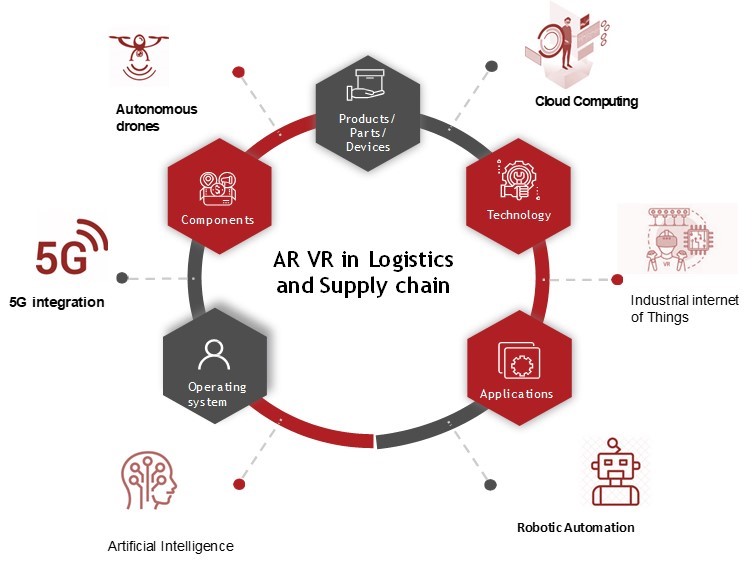Evaluation of AR VR in Logistics and Supply Chain Market Ecosystem:
The global AR VR in logistics and supply chain market ecosystem was valued at US$ 78.5 Mn in 2018 and is expected to reach US$ XX Mn with a CAGR of 39% by 2023. Augmented reality’s ability to avoid the wastage of time and errors while searching the location in warehouses has been creating demand for AR VR in logistics and supply chain in recent years. Additionally, the ability of AR VR to save cost and time for training workers is increasing the use of AR in warehouses for wayfinding.
Moreover, virtual reality is used in warehouses for training workers on safety and emergency in a warehouse environment. This is increasing the demand for VR in warehouses. The German logistics provider DB Schenker, in collaboration with Fraunhofer IML, has announced the use of VR for employee training in order to improve order picking and packaging processes.

Head-mounted display dominated the product, parts & devices segment and was valued at US$ 45.63 Mn in 2018 and is expected to grow with a CAGR of XX% in the coming years. HMD is used for real-time object recognition, indoor navigation, and barcode reading, which provide seamless integration of information with the warehouse management system. At the same time, hand mounted devices also provide hands- free intuitive digital support to workers during their manual picking operations, which has been driving the demand for HMDs in recent years.
At the same time, companies such as Google, Recon, Vuzix, Kopin, and others are focusing on introducing smart glasses in order to improve the accuracy and efficiency of warehouse logistics operations. Owing to the benefits offered by smart glasses, logistics companies have increased the use of smart glasses in recent times. DHL increased its productivity by 15% in 2017 by using smart glasses in their operational processes, as smart glasses provide order picking instructions along with information regarding the location of items in warehouses.
|
Raw Material |
Components |
Products, Parts & Devices |
Software & Services |
Applications |
|
Silicon |
Camera |
Head-Mounted Displays |
Documentation |
3D Modelling/ Design- Shopping |
|
GaN |
Sensors |
Smart Glass |
Visualization |
Training |
|
SiC |
IMU |
|
3D modeling |
|
|
Glass |
Displays |
|
Navigation |
|
|
Plastic |
Processors |
|
Workflow optimization |
|
|
Metals |
Memory |
|
Others |
|
|
Others |
Graphics |
|
|
|
|
|
Audio |
|
|
|
|
|
Module |
|
|
|
|
|
Others |
|
|
|
Based on geography, North America dominated the market in 2018 and is expected to show similar trends in the coming years. The growing e-commerce sector in the region is one of the major factors in creating demand for AR VR in logistics and supply chain. As eCommerce companies such as Amazon are increasing their spending on shipping, the demand for AR VR has increased in order to streamline the process and increase the efficiency of work.
The Asia Pacific is the fastest-growing region with a CAGR of XX% during the forecast period. Fast-growing economies, rising industrial production, increasing purchasing power of consumers are some of the major factors that are driving the growth of the logistics industry in the region. As the logistic industry is growing, the demand for AR VR in logistics and supply chain has been increasing in recent years.
Growing competition among logistics companies is creating demand for on-time delivery to recipients, which in turn, is increasing the use of modern technologies by them for streamlining their processes. Microsoft HoloLens are being increasingly used in warehouses, which provide information regarding the position of items on the pallet. At the same time, it also indicates the right order for picking items.
There are many trends that are having an impact on the market forecast. These, when evaluated from a company’s perspective, can drive growth. Our numerous consulting projects have generated sizeable synergies across all regions and all sizes of companies.
|
Company |
Ecosystem Positioning |
Total Revenue |
Industry |
Region |
|
Magic Leap |
Product Manufacture |
~$180 Million |
AR VR industry |
Global |
|
Google LLC |
Product Manufacture |
$136.22 Billion |
AR VR industry |
Global |
|
Lenovo |
Product Manufacture |
$14 Billion |
AR VR industry |
Global |
|
HTC Corporation |
Product Manufacture |
$0.73 Billion |
AR VR industry |
Global |
|
|
Product Manufacture |
$55 Billion |
AR VR industry |
Global |
Very few markets have interconnectivity with other markets like AR VR. Our Interconnectivity module focuses on the key nodes of heterogenous markets in detail. autonomous drones, cloud computing, industrial internet of things, robotic automation, artificial intelligence and 5G are some of our key researched markets

|
Trends |
Application |
|
Augmented reality is used in warehouse pickup solutions that provide information about the right position of items in the warehouses. Thus, it reduces the time required to complete the order and thereby increases the productivity of warehouse workers. |
Monitoring |
|
Virtual reality is used for training logistics employees such as truck drivers about shipments and warehouse workers about the warehouse. At the same time, it also trains workers about the safety timings of work. |
Training |

Ask for free product review call with the author

Share your specific research requirements for a customized report

Request for due diligence and consumer centric studies

Request for study updates, segment specific and country level reports
